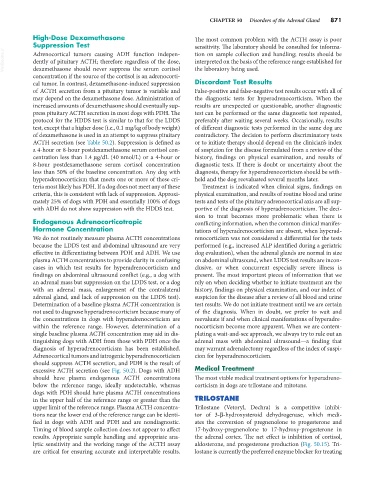Page 899 - Small Animal Internal Medicine, 6th Edition
P. 899
CHAPTER 50 Disorders of the Adrenal Gland 871
High-Dose Dexamethasone The most common problem with the ACTH assay is poor
Suppression Test sensitivity. The laboratory should be consulted for informa-
VetBooks.ir Adrenocortical tumors causing ADH function indepen- tion on sample collection and handling; results should be
interpreted on the basis of the reference range established for
dently of pituitary ACTH; therefore regardless of the dose,
dexamethasone should never suppress the serum cortisol
concentration if the source of the cortisol is an adrenocorti- the laboratory being used.
cal tumor. In contrast, dexamethasone-induced suppression Discordant Test Results
of ACTH secretion from a pituitary tumor is variable and False-positive and false-negative test results occur with all of
may depend on the dexamethasone dose. Administration of the diagnostic tests for hyperadrenocorticism. When the
increased amounts of dexamethasone should eventually sup- results are unexpected or questionable, another diagnostic
press pituitary ACTH secretion in most dogs with PDH. The test can be performed or the same diagnostic test repeated,
protocol for the HDDS test is similar to that for the LDDS preferably after waiting several weeks. Occasionally, results
test, except that a higher dose (i.e., 0.1 mg/kg of body weight) of different diagnostic tests performed in the same dog are
of dexamethasone is used in an attempt to suppress pituitary contradictory. The decision to perform discriminatory tests
ACTH secretion (see Table 50.2). Suppression is defined as or to initiate therapy should depend on the clinician’s index
a 4-hour or 8-hour postdexamethasone serum cortisol con- of suspicion for the disease formulated from a review of the
centration less than 1.4 µg/dL (40 nmol/L) or a 4-hour or history, findings on physical examination, and results of
8-hour postdexamethasone serum cortisol concentration diagnostic tests. If there is doubt or uncertainty about the
less than 50% of the baseline concentration. Any dog with diagnosis, therapy for hyperadrenocorticism should be with-
hyperadrenocorticism that meets one or more of these cri- held and the dog reevaluated several months later.
teria most likely has PDH. If a dog does not meet any of these Treatment is indicated when clinical signs, findings on
criteria, this is consistent with lack of suppression. Approxi- physical examination, and results of routine blood and urine
mately 25% of dogs with PDH and essentially 100% of dogs tests and tests of the pituitary adrenocortical axis are all sup-
with ADH do not show suppression with the HDDS test. portive of the diagnosis of hyperadrenocorticism. The deci-
sion to treat becomes more problematic when there is
Endogenous Adrenocorticotropic conflicting information, when the common clinical manifes-
Hormone Concentration tations of hyperadrenocorticism are absent, when hyperad-
We do not routinely measure plasma ACTH concentrations renocorticism was not considered a differential for the tests
because the LDDS test and abdominal ultrasound are very performed (e.g., increased ALP identified during a geriatric
effective in differentiating between PDH and ADH. We use dog evaluation), when the adrenal glands are normal in size
plasma ACTH concentrations to provide clarity in confusing on abdominal ultrasound, when LDDS test results are incon-
cases in which test results for hyperadrenocorticism and clusive, or when concurrent especially severe illness is
findings on abdominal ultrasound conflict (e.g., a dog with present. The most important pieces of information that we
an adrenal mass but suppression on the LDDS test, or a dog rely on when deciding whether to initiate treatment are the
with an adrenal mass, enlargement of the contralateral history, findings on physical examination, and our index of
adrenal gland, and lack of suppression on the LDDS test). suspicion for the disease after a review of all blood and urine
Determination of a baseline plasma ACTH concentration is test results. We do not initiate treatment until we are certain
not used to diagnose hyperadrenocorticism because many of of the diagnosis. When in doubt, we prefer to wait and
the concentrations in dogs with hyperadrenocorticism are reevaluate if and when clinical manifestations of hyperadre-
within the reference range. However, determination of a nocorticism become more apparent. When we are contem-
single baseline plasma ACTH concentration may aid in dis- plating a wait-and-see approach, we always try to rule out an
tinguishing dogs with ADH from those with PDH once the adrenal mass with abdominal ultrasound—a finding that
diagnosis of hyperadrenocorticism has been established. may warrant adrenalectomy regardless of the index of suspi-
Adrenocortical tumors and iatrogenic hyperadrenocorticism cion for hyperadrenocorticism.
should suppress ACTH secretion, and PDH is the result of
excessive ACTH secretion (see Fig. 50.2). Dogs with ADH Medical Treatment
should have plasma endogenous ACTH concentrations The most viable medical treatment options for hyperadreno-
below the reference range, ideally undetectable, whereas corticism in dogs are trilostane and mitotane.
dogs with PDH should have plasma ACTH concentrations
in the upper half of the reference range or greater than the TRILOSTANE
upper limit of the reference range. Plasma ACTH concentra- Trilostane (Vetoryl, Dechra) is a competitive inhibi-
tions near the lower end of the reference range can be identi- tor of 3-β-hydroxysteroid dehydrogenase, which medi-
fied in dogs with ADH and PDH and are nondiagnostic. ates the conversion of pregnenolone to progesterone and
Timing of blood sample collection does not appear to affect 17-hydroxy-pregnenolone to 17-hydroxy-progesterone in
results. Appropriate sample handling and appropriate ana- the adrenal cortex. The net effect is inhibition of cortisol,
lytic sensitivity and the working range of the ACTH assay aldosterone, and progesterone production (Fig. 50.15). Tri-
are critical for ensuring accurate and interpretable results. lostane is currently the preferred enzyme blocker for treating

